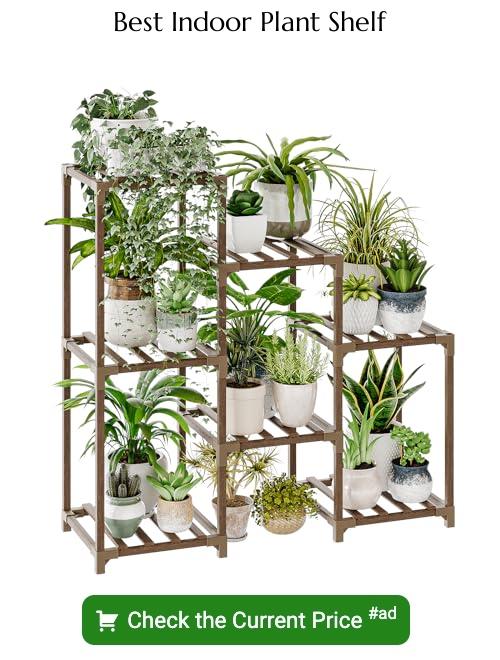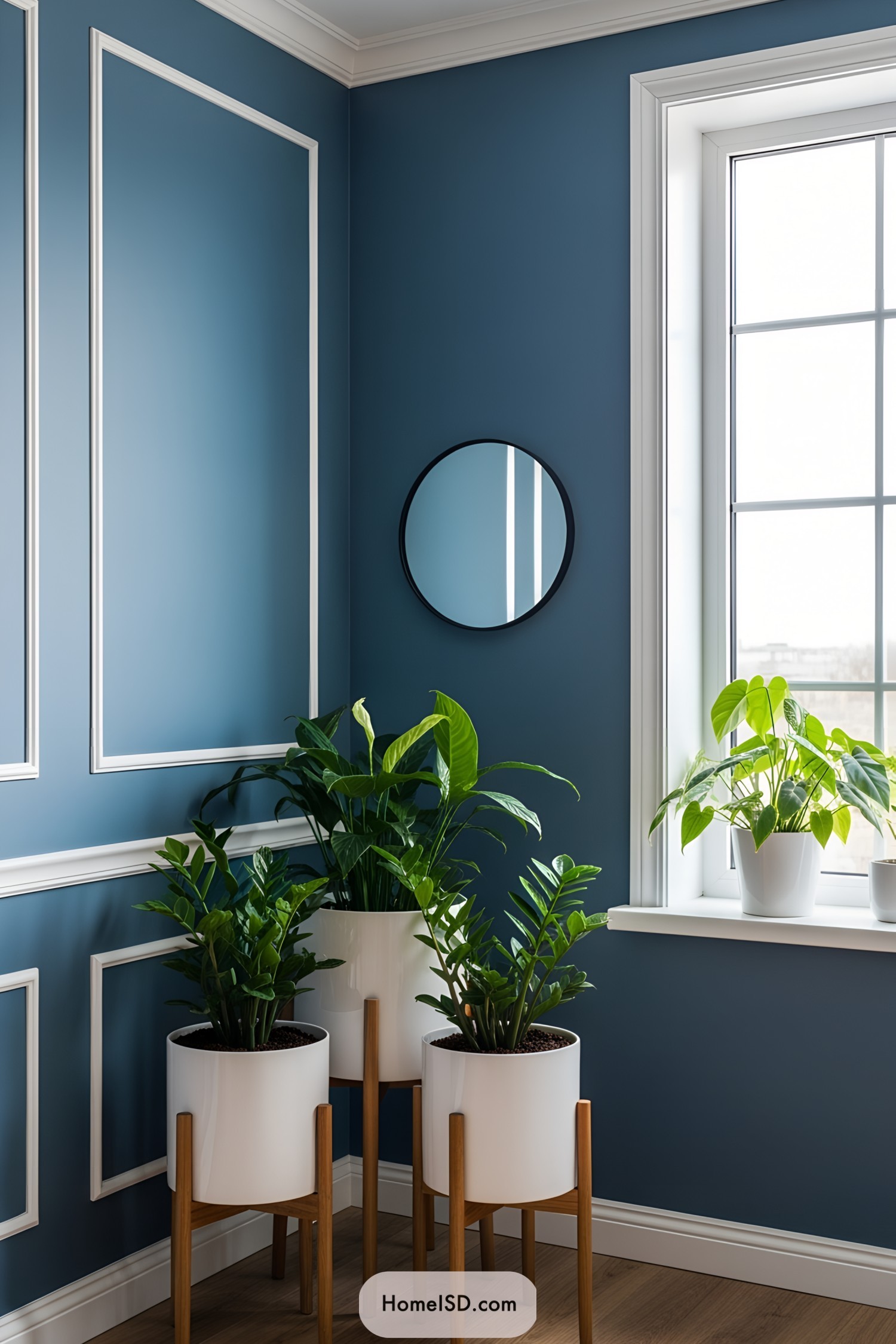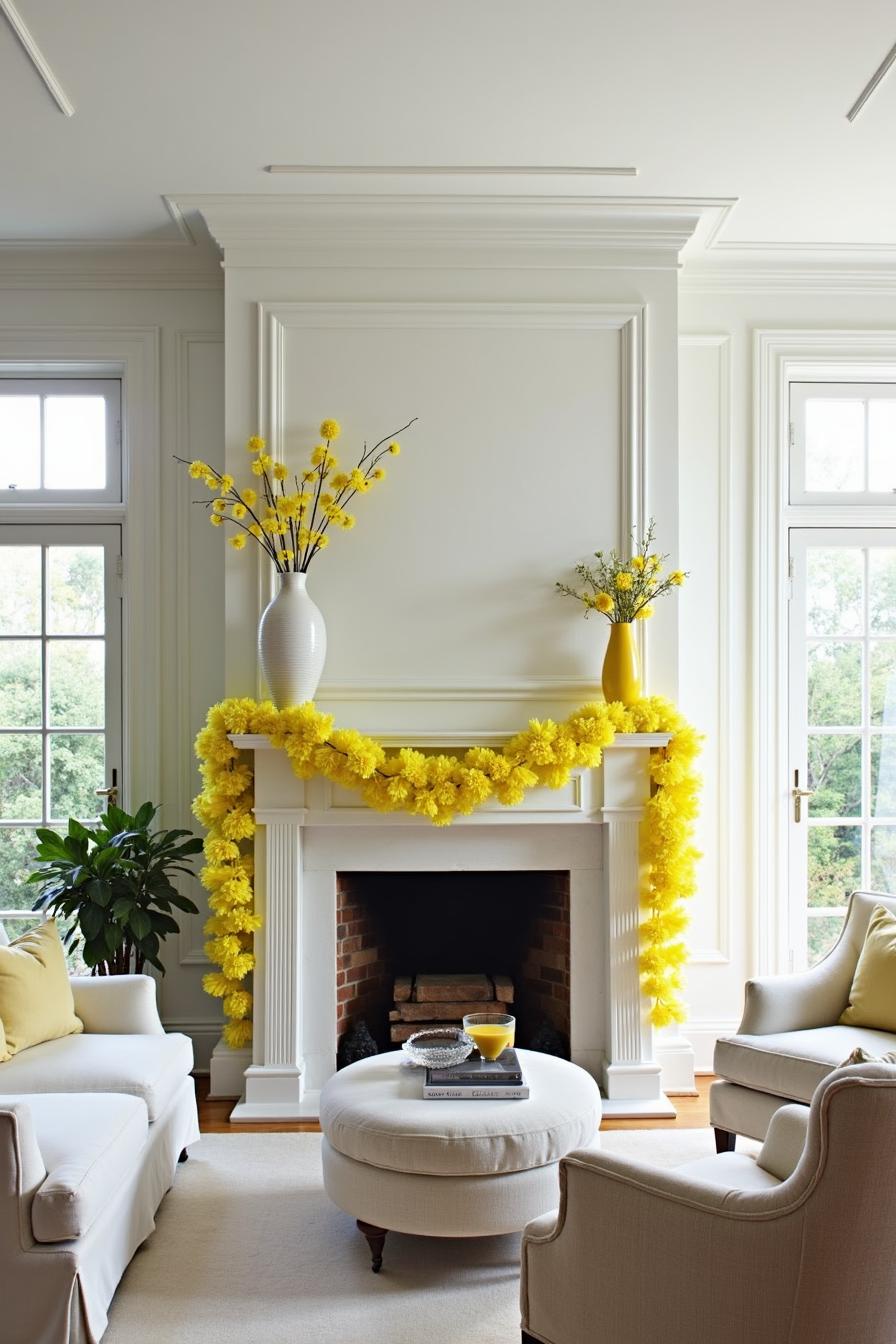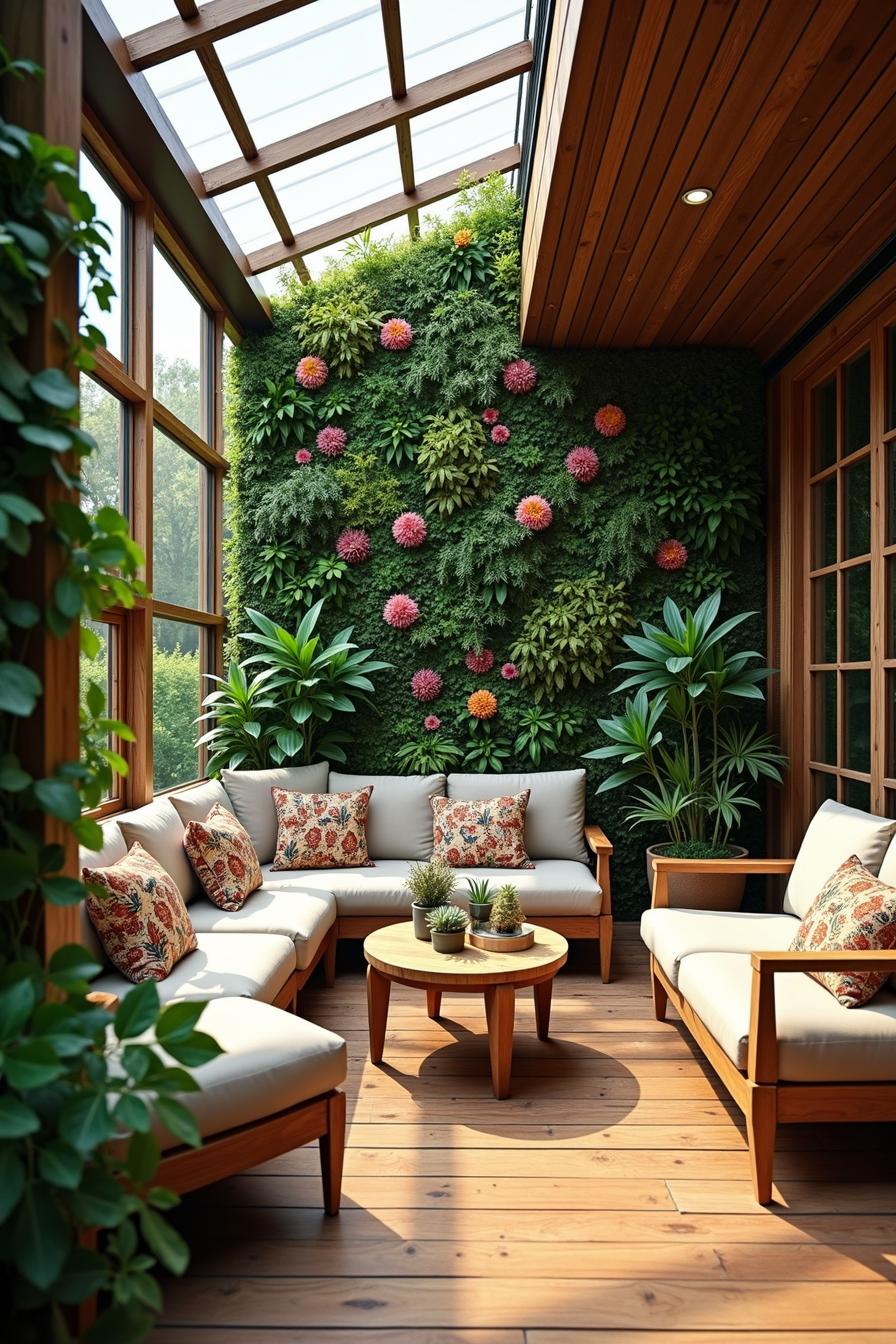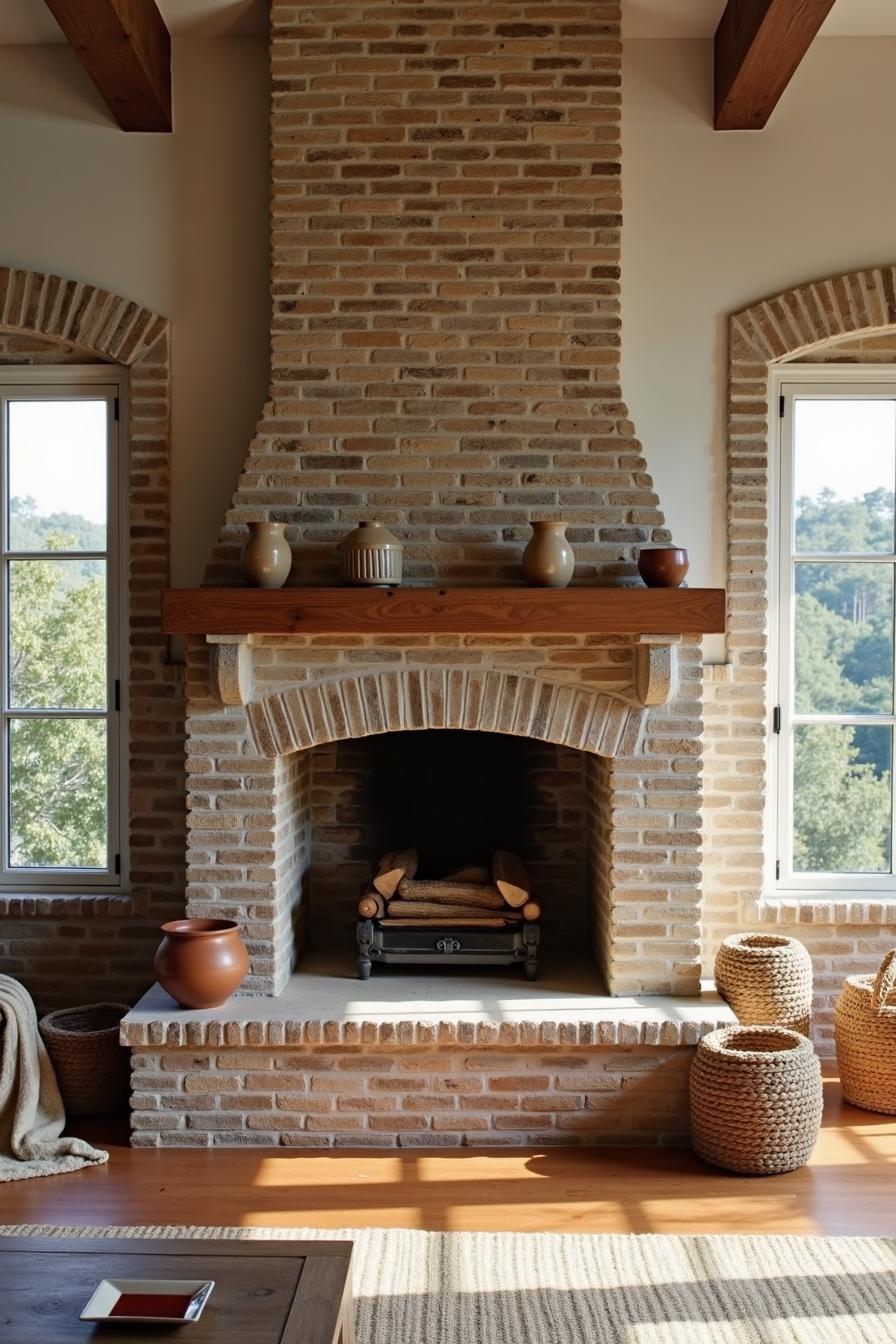Last updated on
Discover how plants can transform any room into a vibrant and relaxing sanctuary because incorporating greenery is a budget-friendly and stylish decor strategy with unexpected benefits.
I am thrilled to share this article and original designs on “20 Plant Room Ideas: Transform Your Indoor Green Space Today,” which I created with great enthusiasm, hoping to inspire and provide as much joy to you as I had in making them.
Transforming a room into a green oasis can be a fun and budget-friendly project. This article will guide you through creative and cost-effective plant room ideas that will not only add a touch of nature to your space but also serve as stunning decor elements.
From hanging plants to create a living chandelier, to using large potted plants as room dividers, we’ve got you covered.
Whether you have a small space or a large room to work with, you’ll find tips and tricks to make the most of your room’s potential.
Stay with us for all the details.
Hanging Plants From the Ceiling
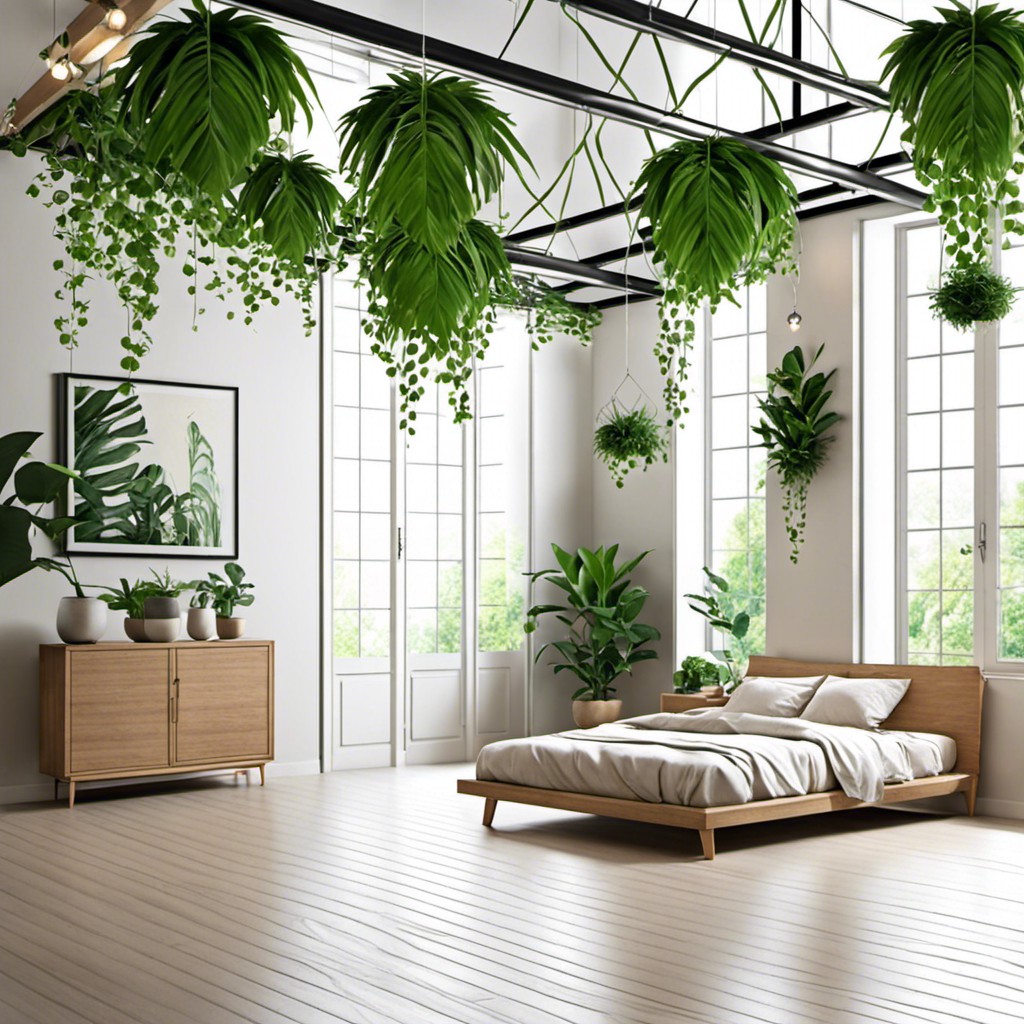
Energizing any room starts at the top. A good mix of hanging plants instantly adds depth, color, and life. Remember, these plants need a lot of sunlight. Near windows or skylights is the best.
Spider plants, ferns, and trailing ivy are great contenders. A sturdy hook and a macramé holder are all you need. Water once a week, taking them down or using a reach extendable watering can. Watch for the leaves’ health for any sign of over or under-watering.
It’s an easy, affordable, and effective way to transform any room into a green oasis.
Succulent Garden On Windowsill

Tropical Plants in the Bathroom
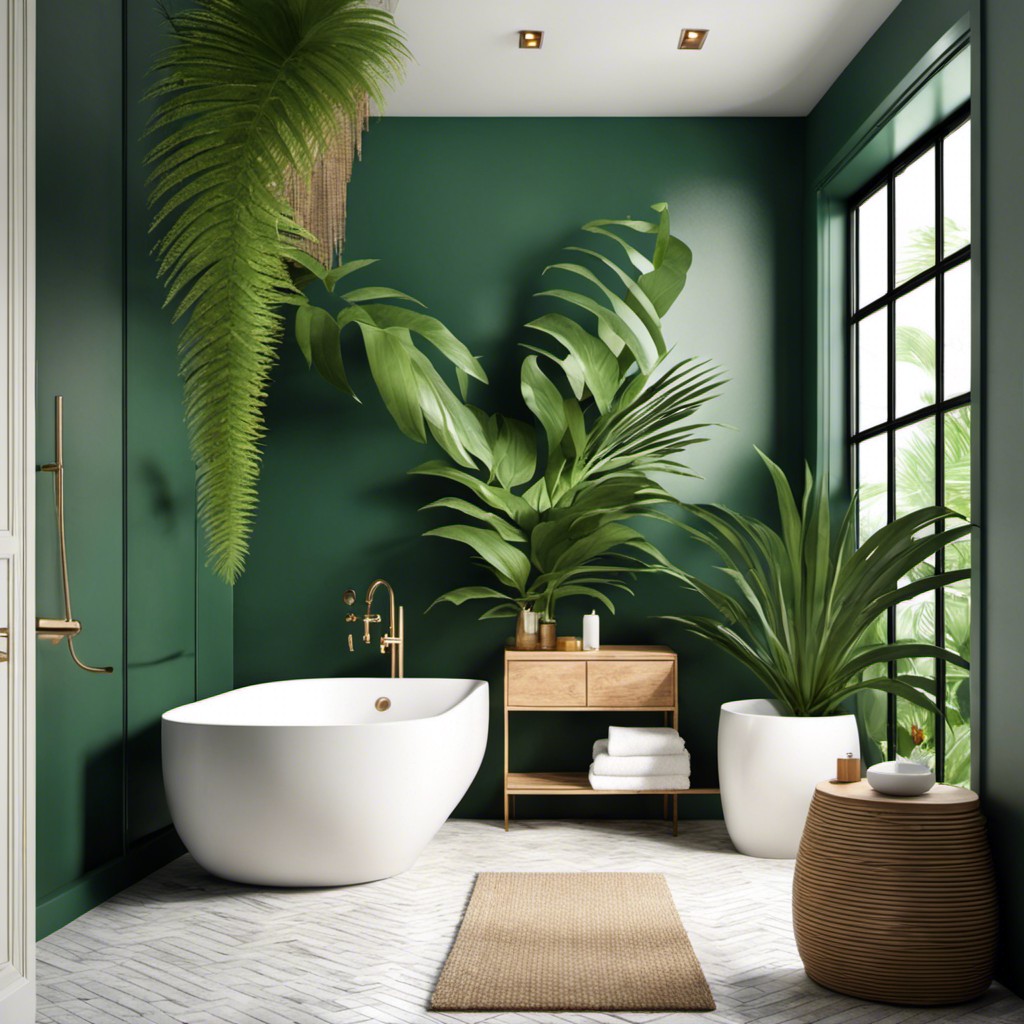
Due to high humidity and often low light conditions, bathrooms can mimic the tropical rainforest environment – an ideal setting for many exotic plants. Start your tropical retreat with plants like Boston ferns, with their lush, arching fronds. They thrive particularly well in humid bathrooms.
Peace lilies also make a great addition. Not only do they add beauty with their dark green leaves and white flowers, but they are also known for their air purifying qualities. Keep it near a window for a little indirect sunlight.
Avoid placing these plants near vents, heaters or drafty windows, to ensure they are always in a warm tropical-like environment. You can also mist them occasionally to maintain the humidity they love. Remember, gold is to avoid waterlogging, as it can lead to root rot.
Lastly, incorporating a Bamboo palm can transform your bathroom into a tropical paradise. They’re easy to care for and do quite well in low-light conditions. This tall, slender plant would fit nicely in a corner behind the tub. Add some pebbles to the bottom for drainage and you’ve got a green, restful oasis that cleans the air, too.
By bringing in these plants, you’re not just adding greenery, but actively enhancing your bathroom’s atmosphere, creating a serene space to unwind.
Indoor Herb Garden in the Kitchen
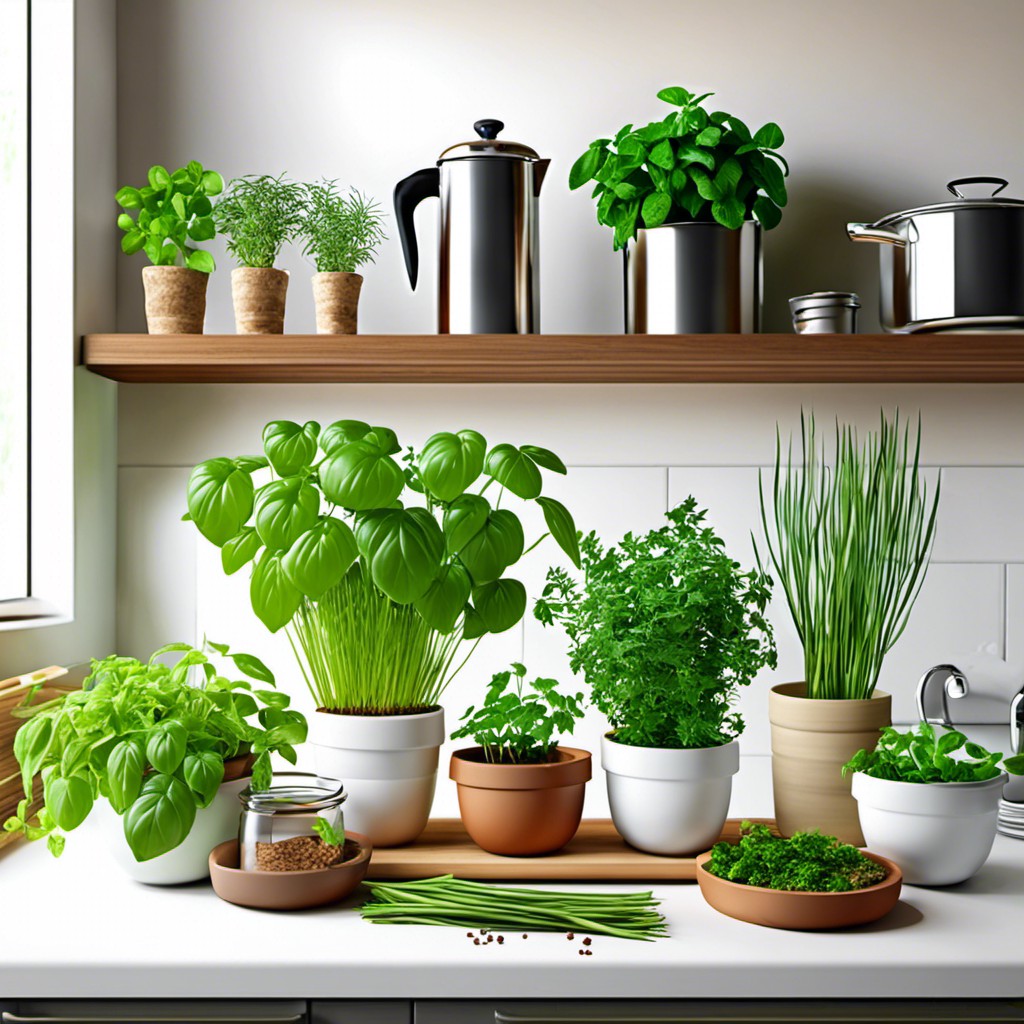
Creating your own indoor herb garden brings flavorful ingredients to your fingertips and adds life to your kitchen. It’s practical, cost-effective, and endlessly useful in cooking. Select herbs such as basil, parsley, cilantro, dill, and rosemary that are commonly used in recipes.
For optimum growth, ensure these key aspects:
- Light: Place herb pots near a south-facing window or under grow-lights.
- Water: Keep the soil damp but avoid overwatering to prevent root rot.
- Pot Drainage: Ensure pots have good drainage holes to avoid water accumulation.
- Good Soil: Use a light potting mix to support root health.
- Spacing: Allow enough space between each plant to prevent overcrowding and to promote healthy growth.
Remember, regular harvest encourages more growth. Happy cooking with your aromatic, fresh homegrown herbs.
Ficus Tree in the Living Room
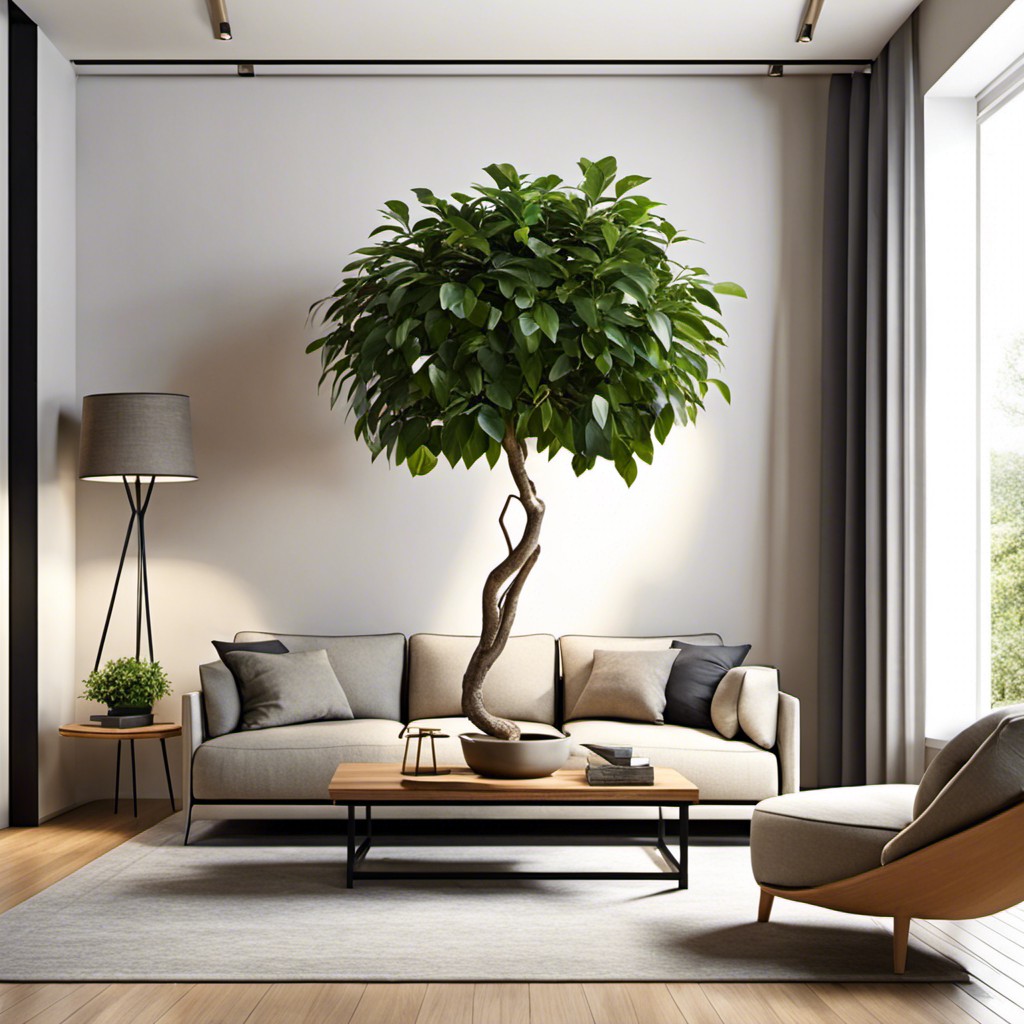
To seize an undeniable touch of elegance, consider adding a Ficus tree. Its tall, arching branches make it the perfect plant to fill in a bare corner or to flank the sofa.
When selecting a spot, keep in mind that Ficus trees prefer indirect sunlight, a position near a south-facing window would be ideal.
Maintaining your Ficus is a straightforward process. Consistent, moderate watering is key, letting the soil dry out between watering. Higher humidity levels are appreciated by this plant, a simple mister can be used to achieve this.
Embrace the versatility of the Ficus. It pairs well with other plants for a lush indoor jungle look, or it can stand alone for a minimalist style. It’s strong silhouette adds character to any living room.
As a bonus, Ficus are known for their air-purifying quality, bringing not just beauty but improved indoor air quality to your living room. Refresh your space and inspire a touch of nature with this all-rounder.
Shelf of Cacti in the Study Room
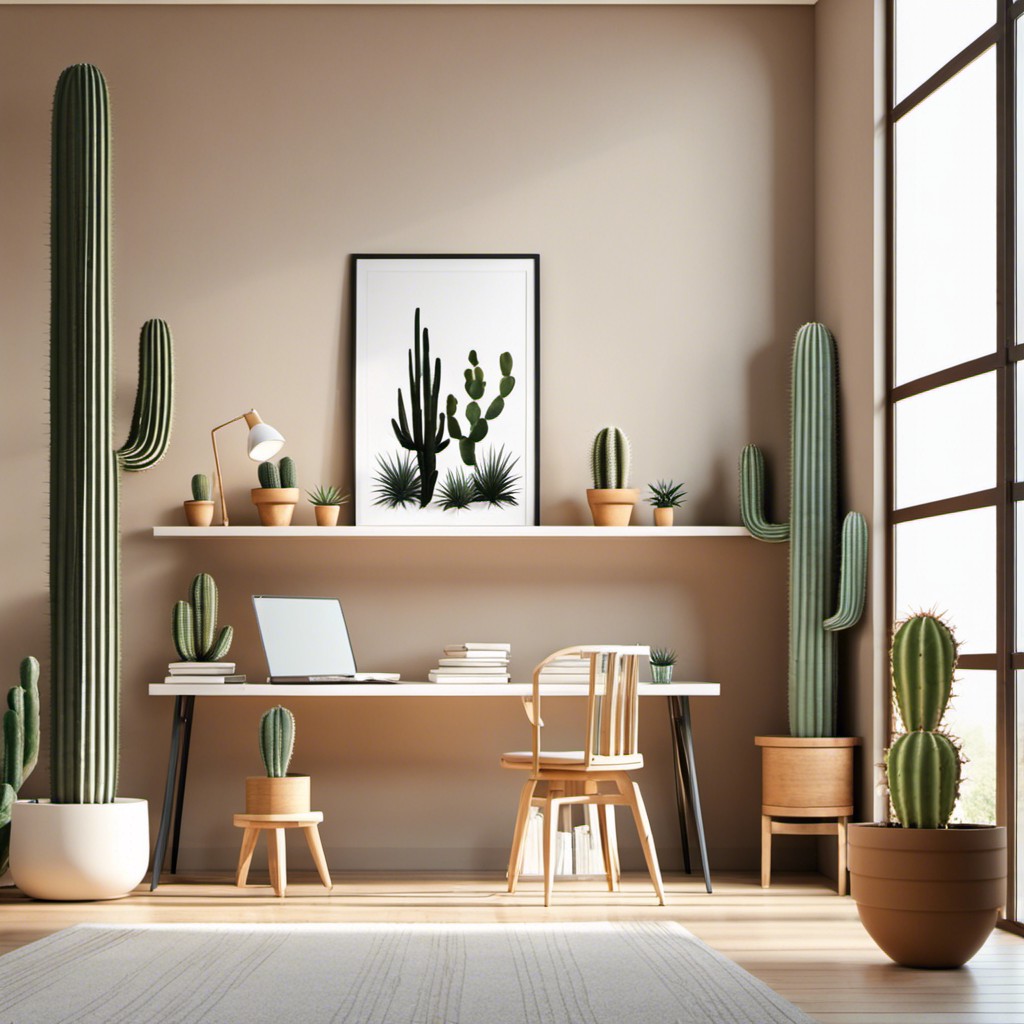
Dedicating a shelf in your study room to an array of cacti not only adds a touch of desert chic, but also aids in creating a focused, natural environment. Cacti require minimal care, making them perfect for busy lifestyles.
Choose cacti of varied shapes, heights, and sizes for an eclectic mix. Pair them with diverse pots featuring patterns, vibrant hues, or neutral tones to match your study room’s aesthetic.
Remember, while cacti thrive in sunlight, they don’t mind shade. Pick a well-lit area, but direct sunlight isn’t necessary. Water sparingly as overwatering can result in root rot.
Introducing cacti on your study room shelf isn’t just pleasing to the eye, it can also improve air quality. Most cacti have the ability to absorb carbon dioxide at night – a helpful trait for maintaining a fresh environment.
Lastly, navigating a compact space? Consider vertical shelving units to display your prickly pals. These units maximize space without sacrificing style. Recycled wooden crates or floating shelves can make an effective, budget-friendly alternative to traditional shelving.
Snake Plant for the Bedroom
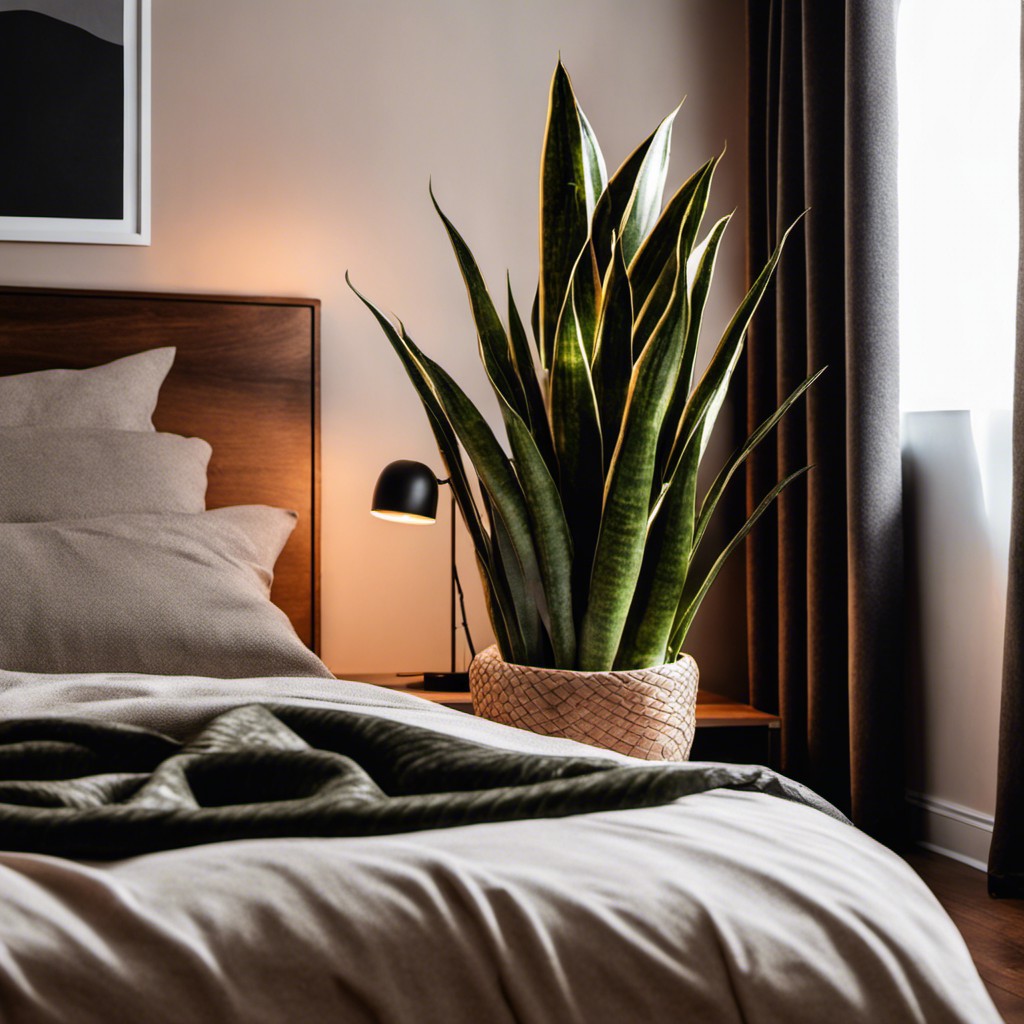
With their strikingly tall and angular leaves, these plants have become a popular choice for the bedroom. They require low light, complementing those corners where much sunlight doesn’t seep in. More importantly, they feature on NASA’s list of air-purifying plants, known for absorbing toxins like formaldehyde and benzene, making it a healthier environment to sleep in.
Incorporate this plant into your bedroom décor by placing it next to a mirror or a tall piece of furniture. Doing so creates an appealing height symmetry. Add a decorative pot – maybe a earthy terracotta one for a rustic feel or a white ceramic pot for a minimalist touch.
Bear in mind, they prefer dry conditions, so avoid overwatering. A tip is to wait for the soil to completely dry between waterings. Also, rotate your snake plant periodically to promote even growth on all sides. Dip in this venture and observe how a humble plant can transform your bedroom into an eco-friendly haven.
Vine Plants Round the Stair Railings
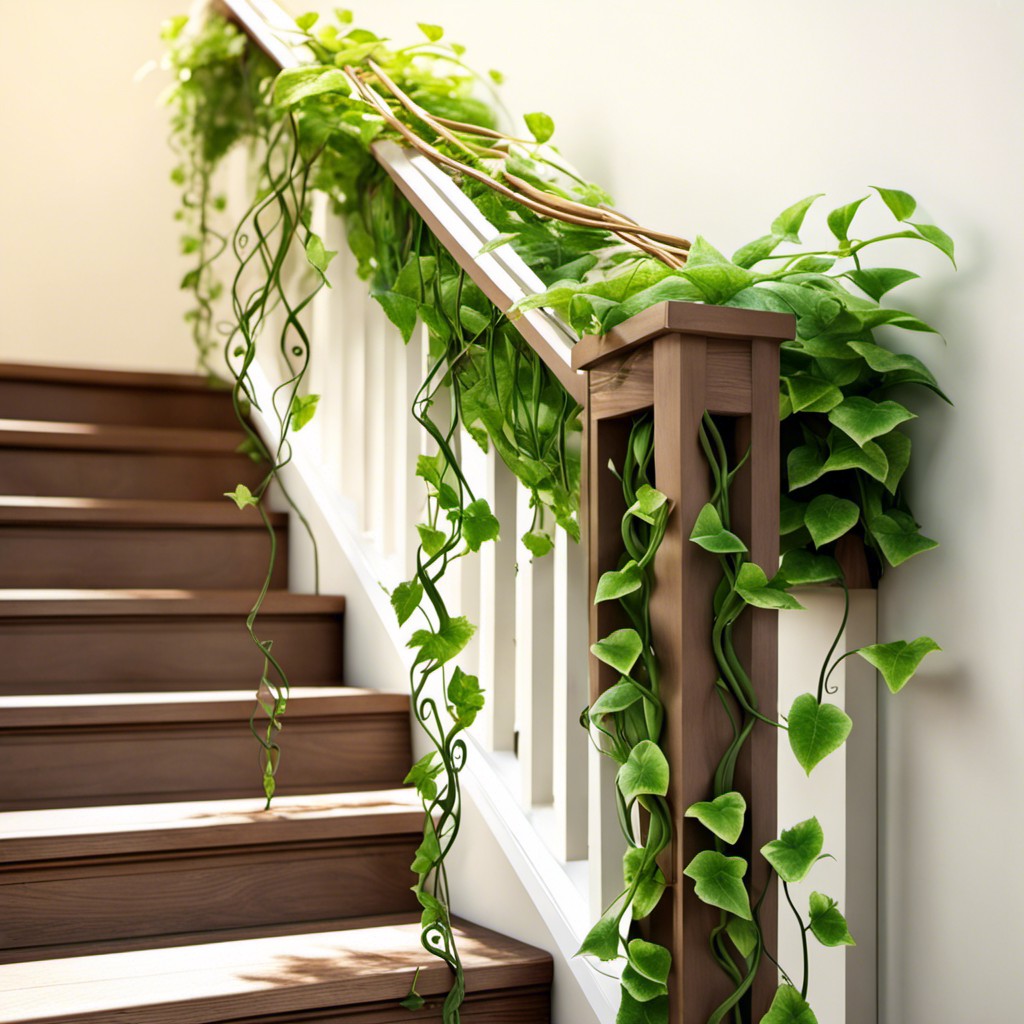
One undeniable charm of vine plants is their ability to crawl, grow, and intertwine gracefully, making stair railings an excellent placement for your lively green decor partner. Here’s how to elevate your stairs’ aesthetic using vine plants:
- Choose species that thrive indoors, such as the English Ivy or Golden Pothos. They have an innate ability to latch onto surfaces, making them excellent stair railing companions.
Consider the light source. Most vine plants appreciate bright, indirect light when indoors. So, if your stairs are close to a window, this placement can be ideal.
Regularly prune your plants. This helps to maintain their form along the railings and avoid unruly growth that could obstruct the stairs’ functionality.
Finally, remember to take into account the care level of the plant. Some might require misting, while others might not, and the same goes for watering frequency. Adorning your stairs with thriving, healthy plants is only achievable if the care notes are diligently followed.
Palm Tree in the Hallway
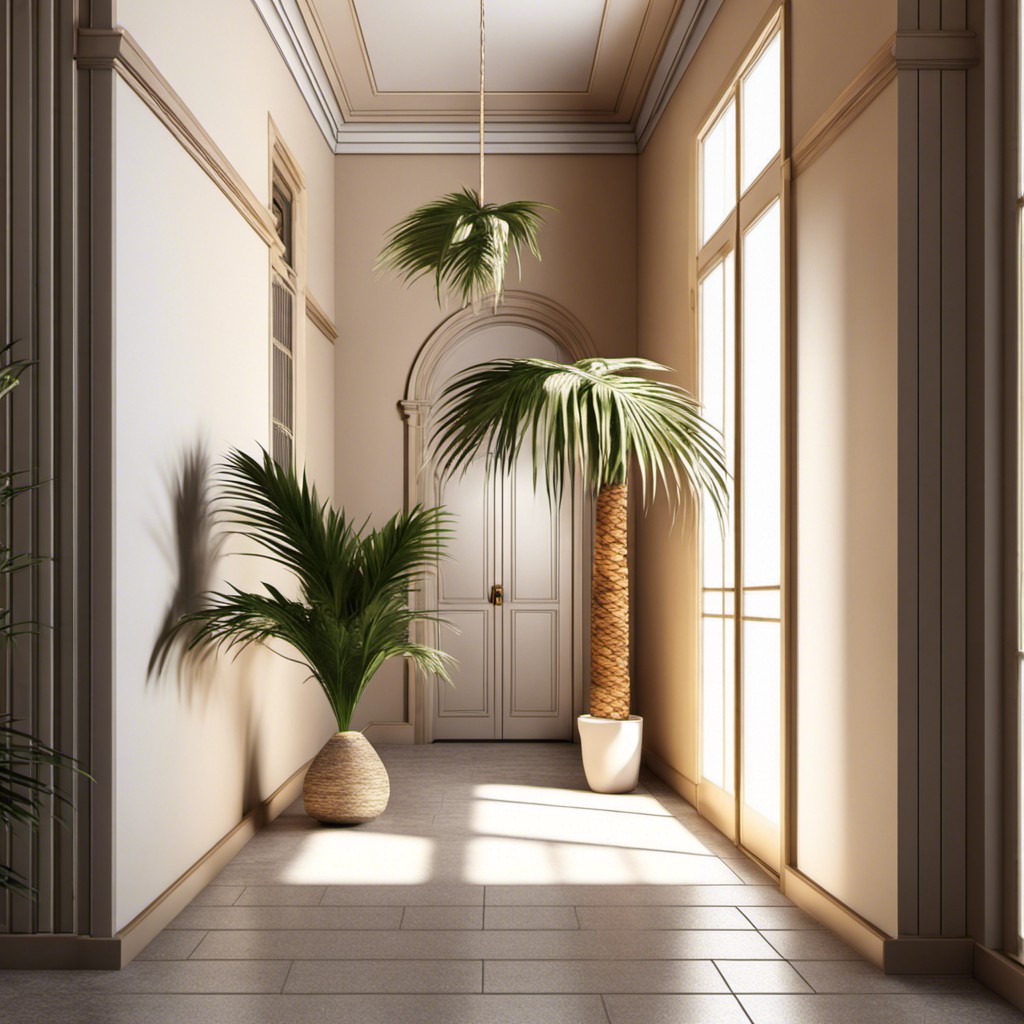
Offering a grand focal point and a slice of the tropics, a palm tree is an excellent choice for a hallway. Luckily, several palm species survive very well indoors with the right care.
First, make sure your hall gets plenty of indirect sunlight, as palm trees require bright lights. If your hallway is a relatively dark place, choose species such as Kentia or Lady palms, famous for their shade tolerance.
The next important thing to consider is space. Palms can grow quite tall, so be sure your hallway has ample vertical room, especially for species such as Majesty or Cat palms.
Remember, these trees love humidity. Keep a pebble tray filled with water near your plant or mist it regularly. In winter, when central heating tends to dry out the air, this is particularly crucial to prevent brown, dry tips.
Lastly, some indoor palms, like Areca or Bamboo palms, can help purify the air by filtering out pollutants. This makes them not just aesthetic additions, but also practical ones for your hallway, ensuring you breathe clean, revitalized air.
So, let your imagination run wild and bring the charm of the tropics right to your home by incorporating a palm tree in your hallway decor.
Fairy Tale Themed Flower Bulbs in Children’s Room
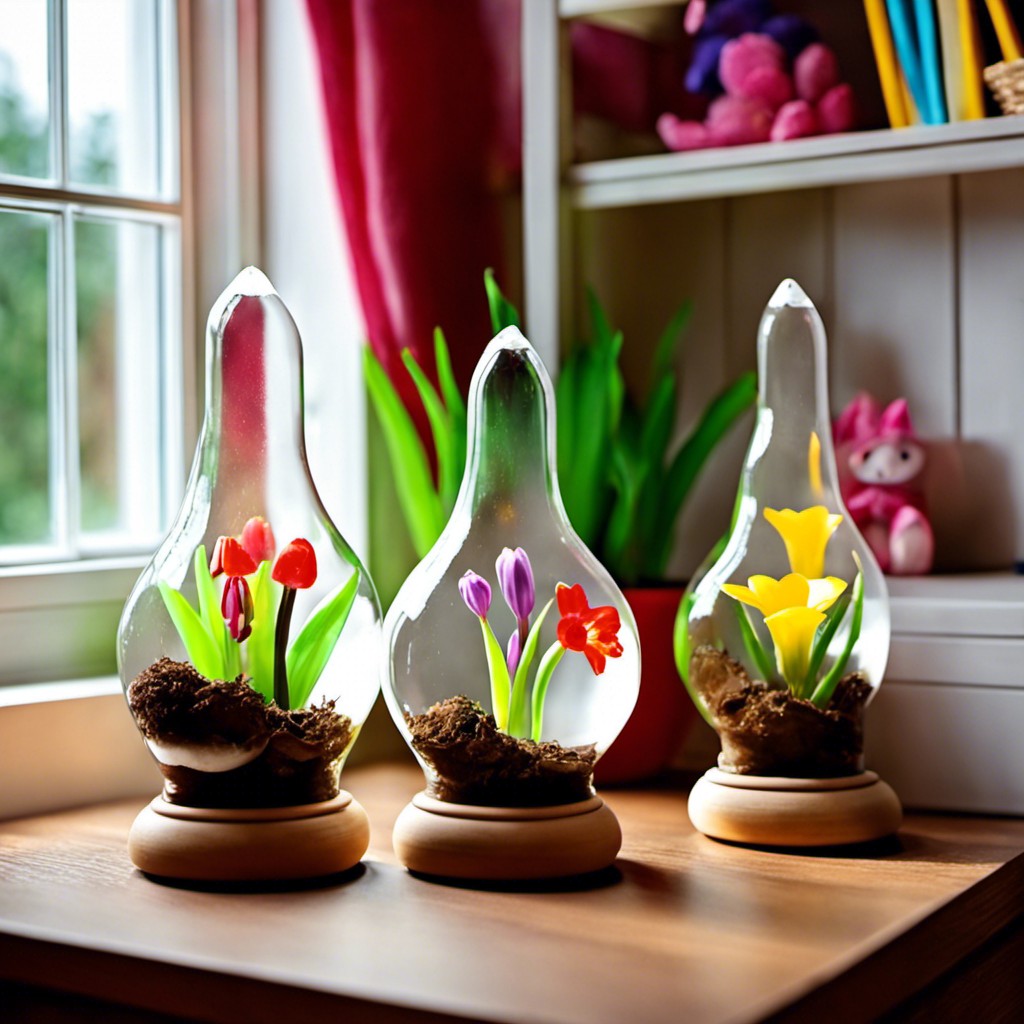
Delight young imaginations with a magical floral wonderland! Opt for bulbs that bloom at different times of the year to ensure a constant display. Consider tulips and daffodils for the spring, gladiolus and lilies for the summer, and dahlias for the autumn. Integrate these blooms with child-friendly themes.
Want a “Snow White and the Seven Dwarfs” motif? Plant seven dwarf varieties of tulips or low-growing lilies. Maybe a “Jack and the Beanstalk” atmosphere intrigues you more? Opt for flowering vines that climb trellises or walls, such as sweet peas.
Remember, it’s also crucial to consider the safety of your children when choosing flower bulbs. Avoid plants that are toxic if ingested or touched. With these tips, you’re ready to transform a simple room into an enchanting fairy tale realm for your little ones.
Rosemary Bush in the Dining Room for Aroma
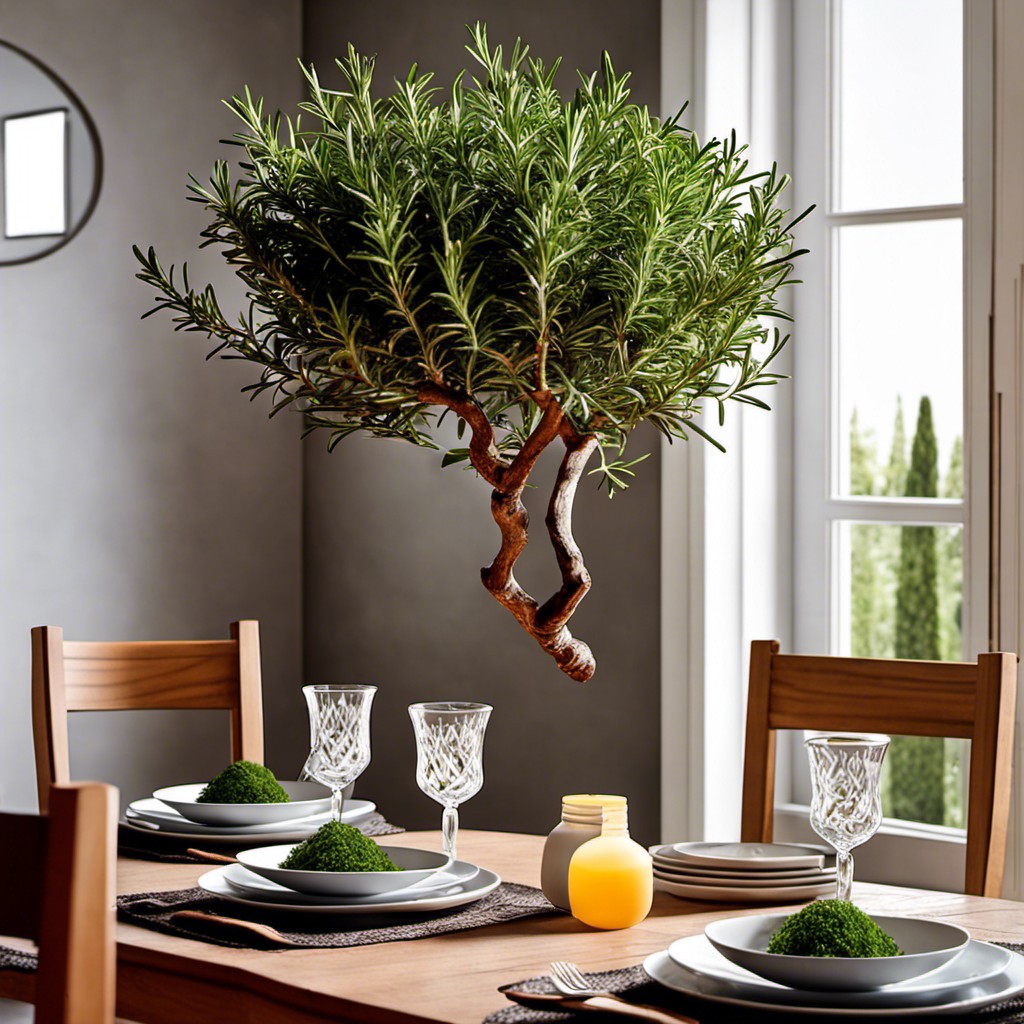
Selecting the right spot for this aromatic herb is crucial. South-facing windowsills or tables close to windows will suit them well as they love sunlight. Remember, the more sunlight they receive, the stronger the aroma. They need at least six hours of indirect sun daily.
Maintaining the correct water level and soil composition is also paramount. Rosemary prefers drier conditions; overwatering can lead to root rot, a common cause of plant failure. A soil mixture that drains well, such as cacti or succulent mix, is ideal.
If you want to amp up the aesthetic appeal, try placing them in quaint, decorative pots that complement your dining room’s decor. Plus, having your rosemary plant in the dining room means it’s always within arm’s reach when you need some leaves to toss into the evening’s pasta dish!
Remember that pruning not only helps to maintain its bushy shape but also encourages more growth. Snip the top two or three inches off each sprig to keep it neat and encourage bushiness.
Take note that rosemary plants can grow quite large if not pruned regularly. If your dining room can accommodate a larger bush, then let it grow! If not, stay consistent with your pruning routine.
When it’s time to entertain, a bushy, well-pruned rosemary plant doubles as a conversation starter, adding a whimsical touch to your space with the added benefit of a refreshing aroma.
Indoor Vertical Garden in the Lounge
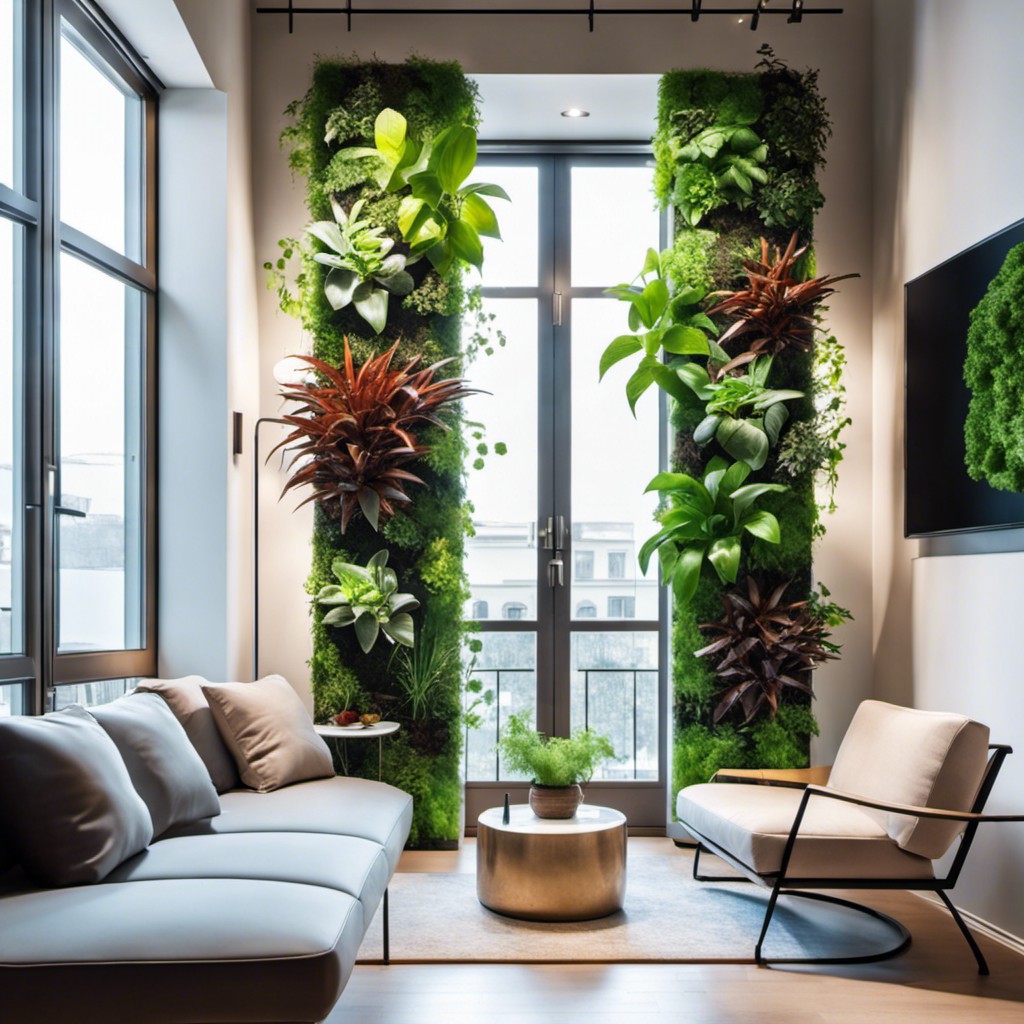
An indoor vertical garden serves as an excellent decor solution that gives your lounge a refreshing aesthetic while maximizing limited space. This eco-friendly project can easily be created at home with a few essential items:
1. Selection of Plants: Opt for a variety of small, low-maintenance plants such as ferns, ivy, or succulents to create a vibrant and diverse display.
2. Right Structure: Use a vertical frame or wall-mounted planters to build your garden upwards. Pallets or wired frames can work perfectly.
3. Irrigation System: Consider a simple drip irrigation setup to ensure your wall garden stays adequately watered without much hassle.
4. Placement: Situate your garden in a location where the plants will receive adequate light but be aware of avoiding the direct afternoon sun that might be harsh for the plants.
Remember, the key to a flourishing indoor vertical garden is regular care, suitable light exposure, and not letting the soil become too drenched or dry. Keep experimenting and rearranging plants to maintain a dynamic, living piece of art.
Ferns Near a Shaded Window
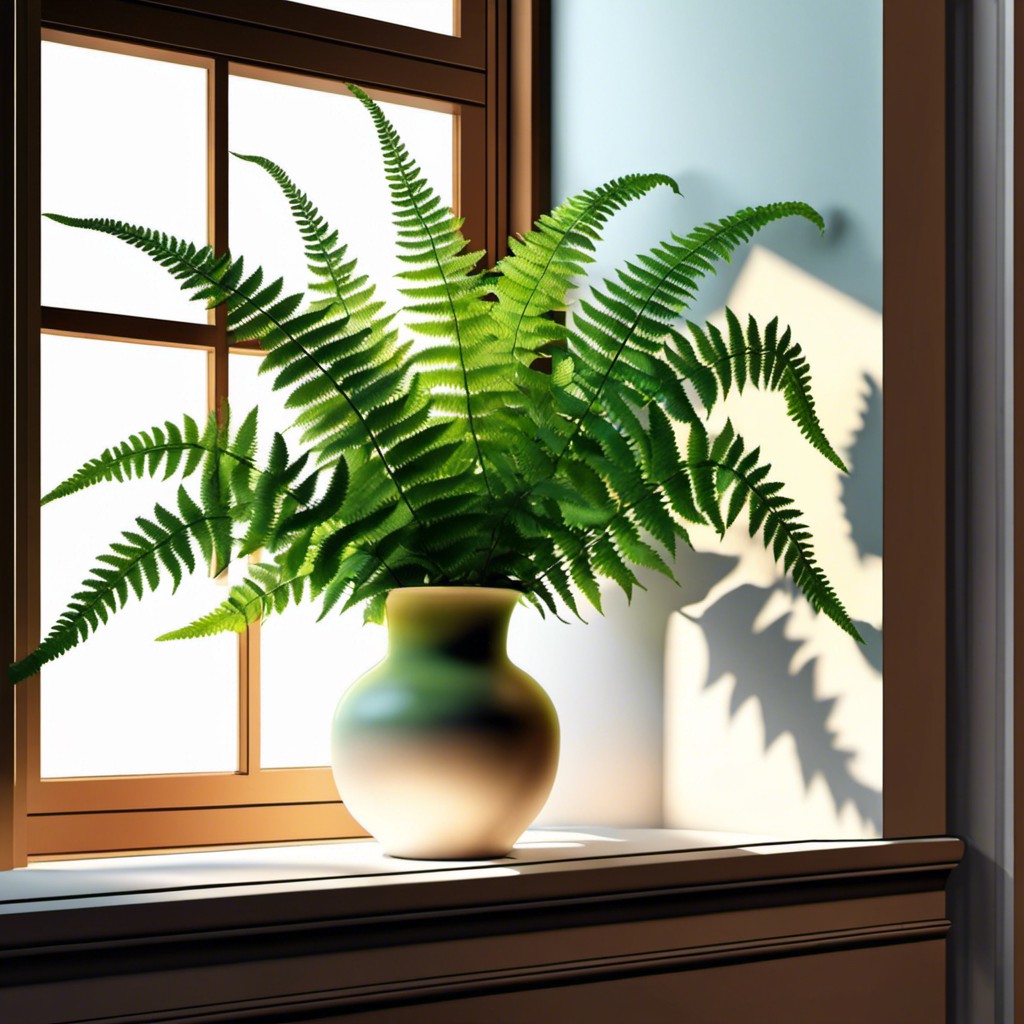
Having ease in maintenance, Ferns offer a vibrant green accent piece which thrives best near windows with abundant indirect sunlight. Start with potted ferns in a size that suits your space. A hanging pot can add a novel touch.
It’s important to keep these ornamental wonders properly hydrated. Though, avoid overwatering, it could risk root rot. Each fern has its unique watering requirements, research the breed you have at home, aim for damp but not soggy soil.
Ferns love a high humidity environment. Regular misting can help mimic this – just a quick spritz using a spray bottle every other day should suffice.
The soil choice is vital too. A well-draining soil mixture comprising peat moss and perlite often works the best. Remember, your fern’s life depends on the right balance of resources, so thoughtful care is paramount.
Add a cool, calm and collected atmosphere to your room with these living greens. Want to go extra? Pair them with a stylish curtain, they’re a match made in heaven.
Air Plants Displayed in Terrariums

Terrariums offer a chic way to display air plants, primarily because they don’t need soil to survive. They absorb moisture and nutrients through their leaves, making them perfect for glass enclosures. Consider hanging terrariums for an extra design flair or station them on a coffee table for a conversation piece.
Embed pebbles, sand or mosses at the bottom for added aesthetics and for managing moisture levels. Their watering needs are minimal, a spritz of water once a week suffices in most cases. While these plants thrive in bright, indirect light, they shouldn’t be exposed to intense direct sunlight. Therefore, place terrariums away from south-facing windows.
Remember, each air plant species is unique. Seek out a variety within the Tillandsia genus, each offering different shapes, sizes, and color hues for a diverse semi-natural landscape. They aren’t just green decor additions but can add pops of pink, purple, red, or silver to your space.
Potted Citrus Trees By the Sunniest Window
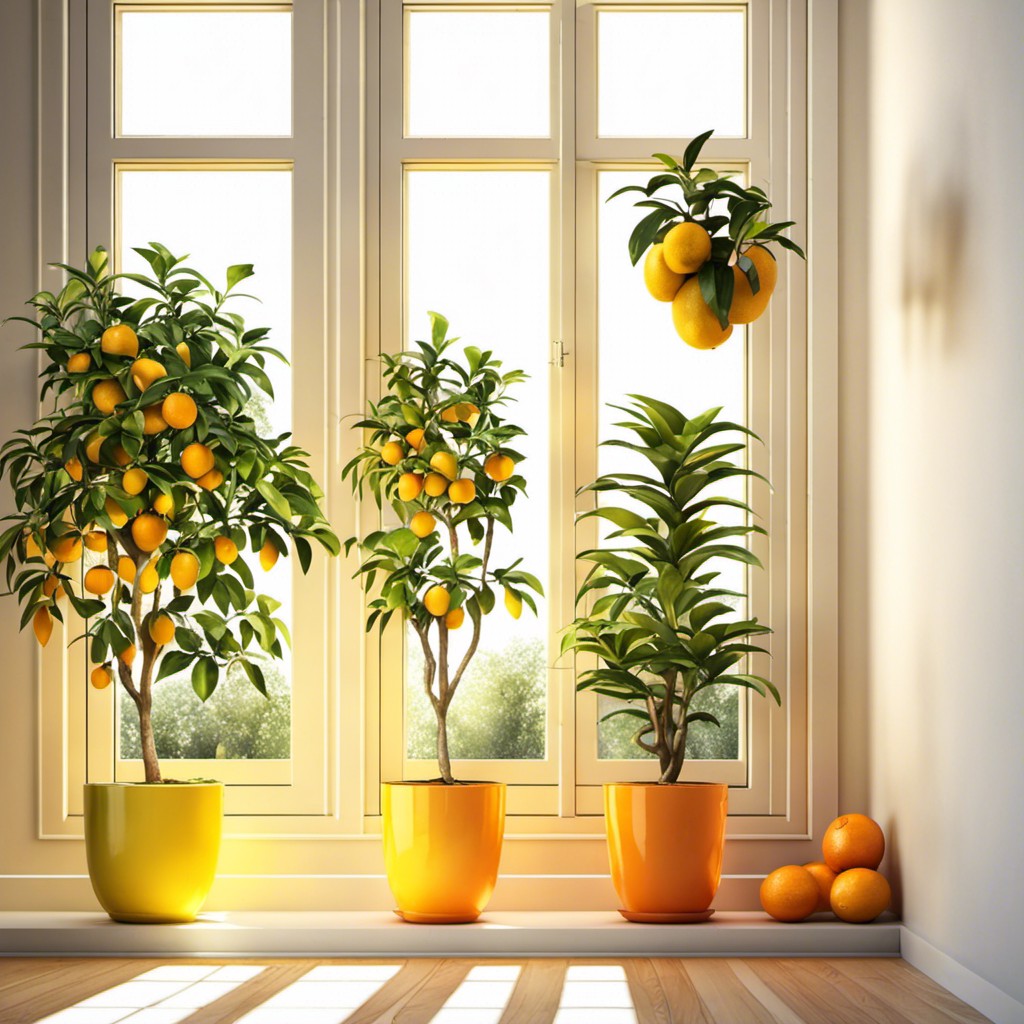
Positioning is key when it comes to showcasing potted citrus trees. They require a good deal of light, typically around eight to twelve hours daily. Thus, placing them by the window with the most sunlight throughout the day is vital.
Do not worry about the size! Even in smaller containment, citrus trees still manage to bear fruit. Dwarf varieties, specifically, are perfect for interior settings. Even with their relatively small size, they don’t compromise on the vibrancy of their foliage and fruit.
Watering needs are also simple to master. Allow the plant’s soil to dry out between waterings to avoid over-saturation. Water until you see moisture come out of the pot’s drainage holes.
For a lasting and healthy display, remember to feed your citrus trees with a slow-release fertilizer specially designed for citrus plants. This should be done from late winter right through to autumn.
Fragrant, practical, and visually appealing, potted citrus trees are a fantastic addition to any home décor attempt on a budget. Both the enjoyments of their aesthetics and the taste of their fruits are yours to take pleasure in!
Butterfly Garden in a Sunroom
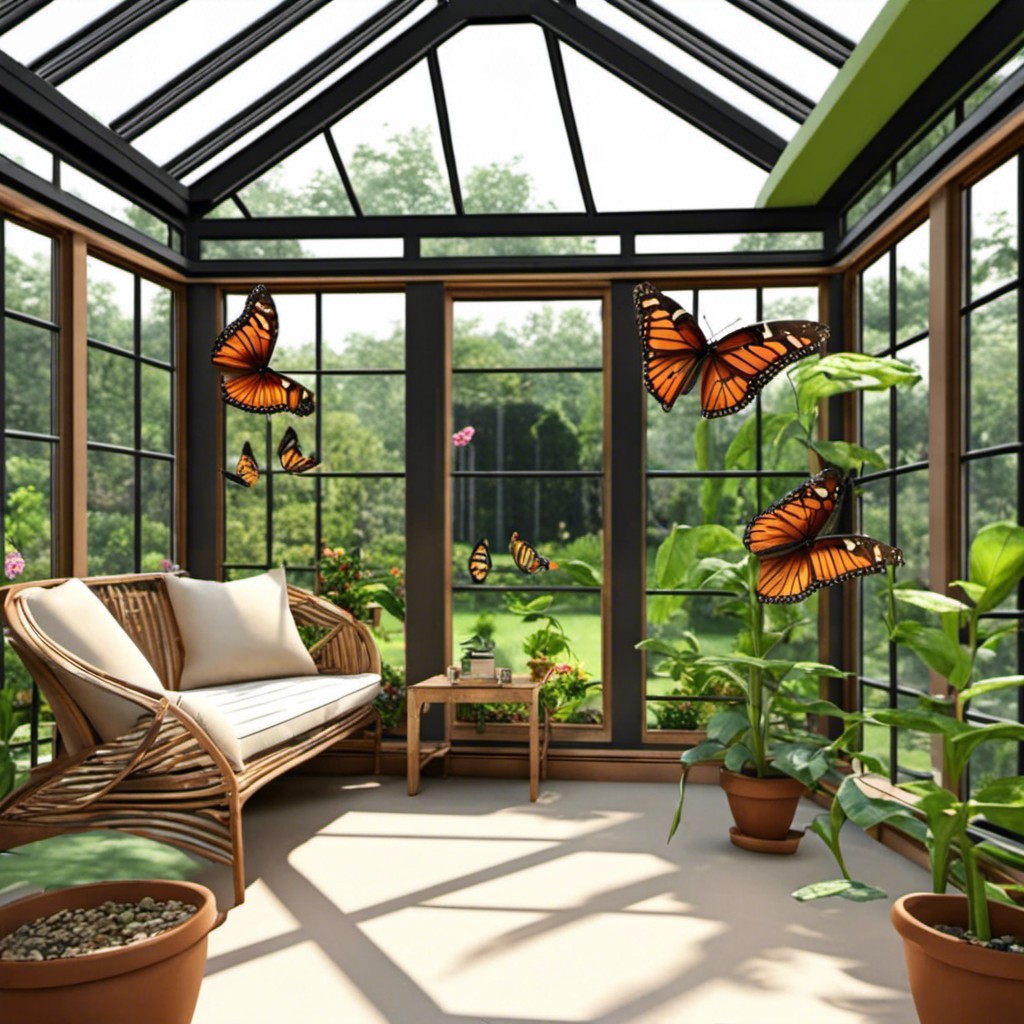
Finding an intersection between nature and interior design shouldn’t be hard. To achieve this, a sunroom dedicated to a butterfly garden can truly be transformative. It’s like creating an all-season, tranquil oasis in your home.
Make sure the sunroom has enough sunlight. Butterflies are cold-blooded and favor warm surroundings. Use nectar-rich blooming plants to create a flitting runway for these beautiful creatures. Butterfly bushes, zinnias, and milkweed are a good start.
The room should also provide resting spaces for them. A few flat stones should do the trick. These creatures often sunbathe. They open their wings wide to soak up the sun. Thus, have a space where they can relax and do just that.
Don’t forget water sources. A shallow dish filled with water or dampened sand can work perfectly to give them a place to drink.
Keeping these in mind, the butterfly garden in your sunroom is not just a decor trick. It’s a miniature ecosystem running right inside your home.
Orchids in the Master Bedroom

Choosing an uncluttered area with access to indirect light, such as a bedside table or a dresser, is perfect to place these exotic beauties. Bear in mind, while orchids enjoy humidity, they should not be waterlogged. A watering schedule of once a week in winters and twice in summers work suitable for most. Use of a specialized orchid fertilizer every two weeks in their growing period can boost their health.
To cater to the humidity needs, consider placing them on a tray filled with pebbles and a little water. Maintain a consistent temperature, preferably between 60-75°F, for their optimal growth. Remember to provide ventilation to prevent disease. Rotation of pots every few weeks can allow for even exposure to light, promoting symmetrical growth.
Aren’t they a remarkable addition lending a touch of elegance and tranquility to your bedroom?
Terrace With a View Dedicated to Bonsai

Creating a haven of miniature trees on your terrace can dramatically transform your space into a tranquil getaway. Bonsai, a Japanese art form, features precisely pruned, small trees that mimic larger ones’ shape and scale.
Here are some key points to remember:
- Choice of Bonsai: Bonsai varieties such as Juniper, Ficus, and Pine do well outdoors. These species can withstand variable weather conditions to thrive on a terrace.
- Container Choice: Traditional ceramic pots which are shallow and wide are a good choice for displaying bonsais. The container should have proper drainage holes to prevent root rot.
- Positioning: Ideally, place these tiny trees where they’ll receive at least five hours of indirect sunlight daily. Locate them so they can be admired from indoors and add value to your view.
- Maintenance: Regular and careful pruning is needed to keep the bonsais small and to maintain their shape. Water the trees maintaining a balance without overhydrating or dehydrating them.
- Layout: Arrange your bonsais at different heights for increased visual appeal. The use of stands, shelves, or pedestals can enhance aesthetics.
Remember, bonsai are living art pieces that require more care and attention than common houseplants. However, the aura of calmness and connection with nature that they emanate makes the effort worthwhile.
Miniature Rose Bushes By Front Entrance

Taking pride of place in entryways, miniature roses add an immediate pop of color and welcome warmth in your home. They are enchantingly small but don’t let their size fool you – they are just as sun-loving as their larger counterparts needing six hours of direct sunlight each day.
Successfully maintaining these miniatures involves understanding both their light and watering needs. They enjoy well-drained soil and do not like to feel waterlogged. Hence, watering once a week should serve them well. Deadheading or cutting them back promotes further blooms and maintains an aesthetic look.
For a more personal feel, choose hues that match or complement your interior colors. If you’re charmed by their look, consider fragrant varieties to add another sensory experience upon entering your home. If you have pets, ensure the variety you choose is non-toxic to them.
Consider using a decorative pot or planter that will complement your decor and serve as an additional design element. Thinking creatively about the container you choose will add character and guarantee that your tiny roses take center stage as guests arrive.
Corner Dedicated to Prayer Plants
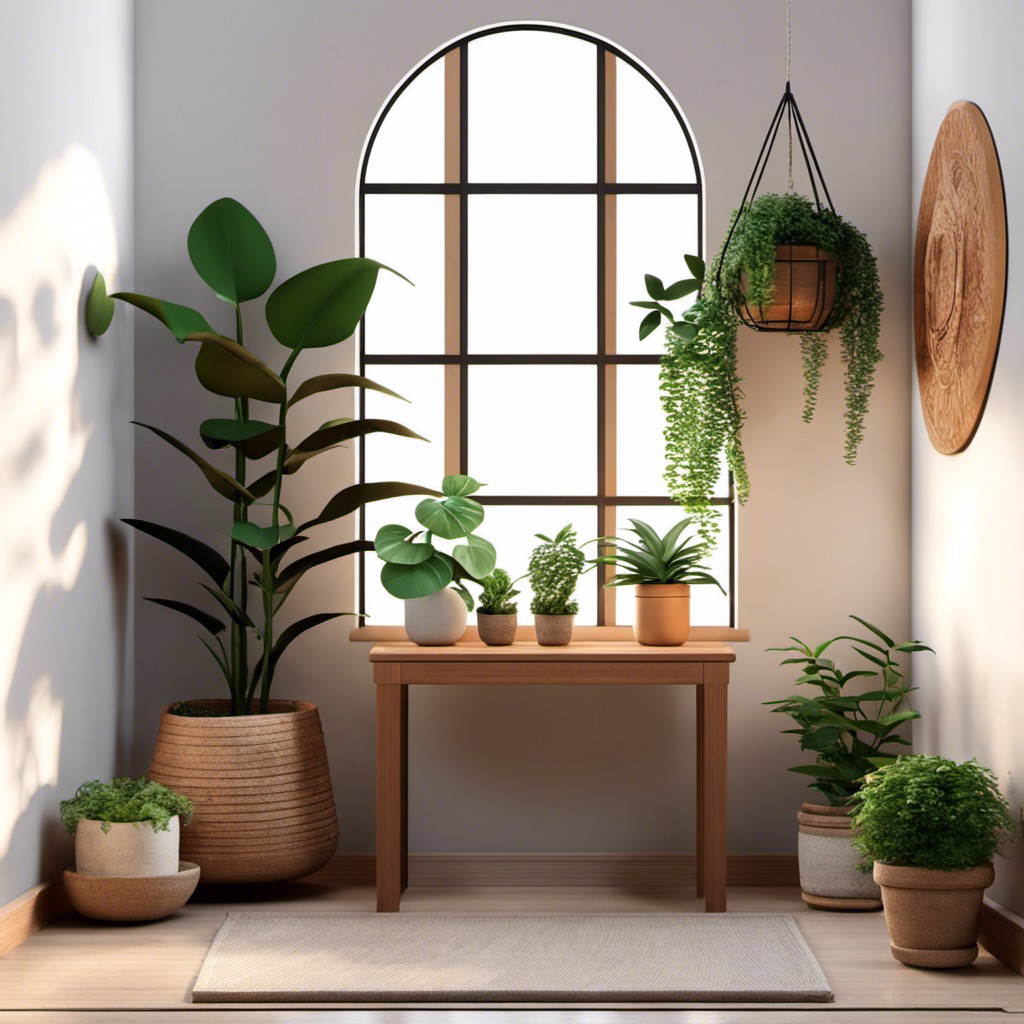
Ensuring you have a dedicated space for these unique indoor plants is key to creating a serene atmosphere. Here are some key points to bring this idea to life:
1. Lighting: Prayer plants thrive in bright, indirect light. Too much sun can harm their beautiful leaves, therefore, position them near a north or east-facing window.
2. Containers: Select a container that complements your decor. Remember, it should have good drainage to prevent overwatering.
3. Humidity: These plants love moisture! Consider placing a small humidifier nearby or frequently misting them to maintain the right atmosphere.
4. Arrangement: Prayer plants are compact, so you could layer them, putting smaller ones in the front and taller ones in the back.
5. Accents: Introduce a pop of color to your corner with a colorful stand, tablecloth or pot for these stunning plants.
6. Companion plants: Pair them with other low-light loving plants for a lush, tropical vibe in your corner.
7. Consistency: Remember to maintain a regular watering and misting routine to keep your corner thriving and vibrant.
This dedicated prayer plant corner is sure to become a beloved, relaxing nook in your home, providing the perfect balance between aesthetics and nature.
Recap
